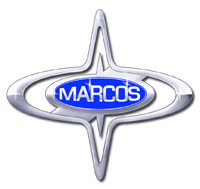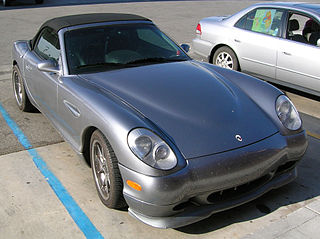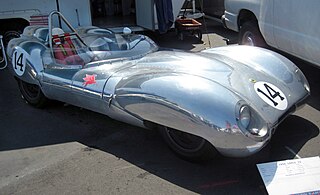
The Lotus Elise is a sports car conceived in early 1994 and released in September 1996 by the British manufacturer Lotus Cars. A two-seater roadster with a rear mid-engine, rear-wheel-drive layout, the Elise has a fibreglass body shell atop its bonded extruded aluminium chassis that provides a rigid platform for the suspension, while keeping weight and production costs to a minimum. The Elise was named after Elisa Artioli, the granddaughter of Romano Artioli who was chairman of Lotus and Bugatti at the time of the car's launch.

The Lotus Elite name has been used for two production vehicles and one concept vehicle developed and manufactured by British automobile manufacturer Lotus Cars. The first generation Elite Type 14 was produced from 1957 until 1963 and the second generation model from 1974 until 1982. The Elite name was also applied to a concept vehicle unveiled in 2010.

The Lotus Europa name is used on two distinct mid-engine GT cars built by British automobile manufacturer Lotus Cars. The original Europa and its variants comprise the Lotus Types 46, 47, 54, 65 and 74, and were produced between 1966 and 1975.

Marcos Engineering was a British sports car manufacturer. The name derives from the surnames of founders Jem Marsh and Frank Costin.

The Lotus Esprit is a sports car built by Lotus Cars from 1976 to 2004 at their Hethel, England factory. It has a rear mid-engine, rear-wheel-drive layout. Together with the Lotus Elise / Exige, it is one of Lotus' most long-lived models.

The Esperante is a sports car made by Panoz, an American car manufacturer.
Francis Albert Costin was a British automotive engineer who advanced monocoque chassis design and was instrumental in adapting aircraft aerodynamic knowledge for automobile use.

The Opel GT is a front-engine, rear-drive two-seat sports car manufactured and marketed by Opel in two generations separated by a 34-year hiatus.

The Ferrari 250 Testa Rossa, or 250 TR, is a racing sports car built by Ferrari from 1957 to 1961. It was introduced at the end of the 1957 racing season in response to rule changes that enforced a maximum engine displacement of 3 litres for the 24 Hours of Le Mans and World Sports Car Championship races. The 250 TR was closely related to earlier Ferrari sports cars, sharing many key components with other 250 models and the 500 TR.

The Morgan Aero 8 is a sports car built by Morgan Motor Company at its factory in Malvern Link, England from 2000 until 2018.

The Saleen S7 is an American hand-built, high-performance sports car designed and built by American automobile manufacturer Saleen Automotive Inc. Developed jointly by Steve Saleen for the initial concept, direction and engine, Hidden Creek Industries for resources and initial funding, Ray Mallock Ltd. (RML) for chassis, suspension and aerodynamics, and Phil Frank for the body and interior CAD design and development.

The Opel Manta is a rear-wheel-drive sports coupé built by German manufacturer Opel in two generations from 1970 to 1988. The Manta was a mildly sporting coupé based on the Ascona family car, competing with cars such as the Ford Capri. The Manta remained rear-wheel drive for both generations and also saw certain competition success. Its name comes from the manta ray.

The Lotus Europa S is a sports car built by the British company Lotus Cars from 2006 until 2010. It has a rear mid-engine, rear-wheel-drive layout and was designed to be a more comfortable variant of the driver-focused Lotus Elise and its derivative, the Exige. The Europa S revived the Europa nameplate previously used in the 1960s and 1970s.
The TMC Costin is a Clubman-style sports car built from 1983 to 1987 in Castlebridge, County Wexford, Republic of Ireland. Fewer than forty were produced.

The Panoz Roadster is a sports car launched in 1992 by the American manufacturer Panoz Auto Development Company of Georgia. The Roadster was succeeded by the AIV Roadster in 1997. They were built using aluminum, similar to that of the Plymouth Prowler first sold several years later in 1997. The Panoz Roadster was the first American-built aluminum intensive vehicle.

The Lotus Mark VIII car was Colin Chapman’s first fully enclosed aerodynamic design. Chapman's basic requirements for the design were for a car of 1100 lbs powered by an 85 bhp engine and a maximum speed of 125 mph. Work began on this design in late 1953 and Chapman was assisted in the design of the body by the aerodynamicist Frank Costin, who was the brother of Mike Costin, his main collaborator.

The Vauxhall Wyvern is a medium-sized family car introduced by Vauxhall in 1948 as a successor to the Vauxhall 12. The name comes from the mythical beast the wyvern, and may be due to a misidentification of the heraldic griffin on the Vauxhall badge.

The Lotus 15 is a front-engine sports racing car designed by Colin Chapman of Lotus, built from 1958 until 1960.

The Marcos GT is the name used by the British firm of Marcos Engineering Ltd for all of their cars until the introduction of the Mantis in 1970. Most commonly, the name is used to describe the very low coupé designed by brothers Dennis and Peter Adams.

The Mercedes-AMG GT 4-Door Coupé is an executive car (E-segment) introduced in 2018 by Mercedes-AMG. It is marketed as a five-door variant of the AMG GT two-door sports car. Despite the name and style, the GT 4-Door Coupé is closely related to E63 wagon with its performance chassis, and is featured by the AMG-specific rear frame and a different front axle for better kinematics.



















